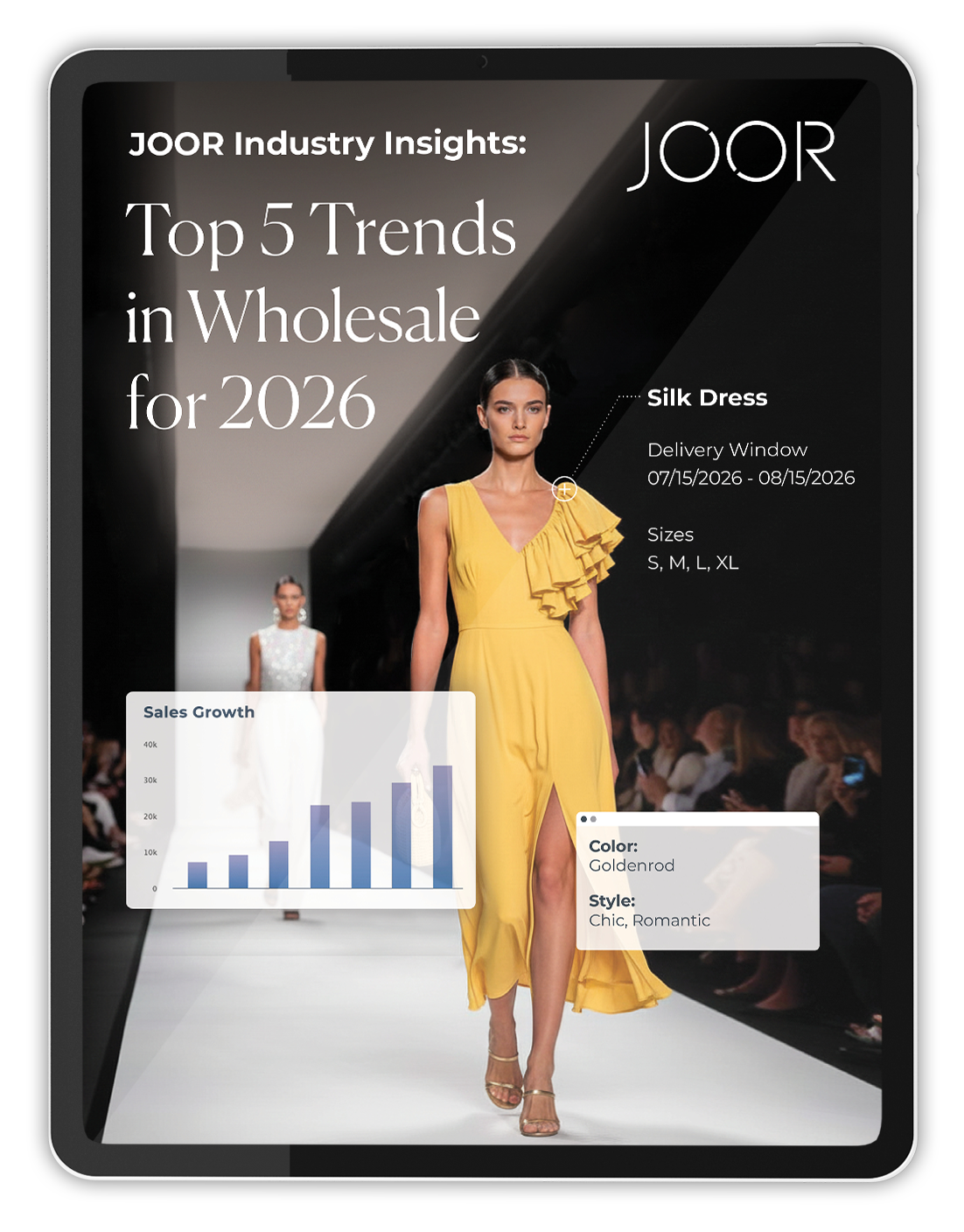What Is a Line Sheet?
A line sheet is a catalog-like sales tool and an essential part of the wholesale business. Line sheets feature photos of every look in a specific collection. Key product details help brands make the sale.
For example, a quick look at suggested retail prices might let a buyer realize a brand isn’t a great fit for their target market. Similarly, sophisticated finishings and fabrics might make a buyer curious to see more.
Line sheets offer insights into:
- Key fabrics and textiles
- Finishings
- Color palettes
- Size ranges
- Wholesale and suggested retail prices
- Key features, such as:
- Wrinkle resistance
- Performance fabrics (e.g. moisture wicking or water resistance)
- Hidden pockets
Finally, while you might only see one version of a style on the runway, a line sheet shares every associated SKU. Retailers can see every available color, fabric, or feature on offer for any given SKU.
Benefits of Line Sheets in B2B Wholesale
Buyers use line sheets to quickly scan for all the information they need - digital line sheet tools take things even further. Buyers can shop from them directly, zoom into photos for a better sense of product details, and more.
Linesheets allow for:
- Placing orders in just a few clicks
- Essential product information at a glance
- Zoomable images for product and fabric details
- Ability to curate custom assortments for specific buyers
Example of a Line Sheet
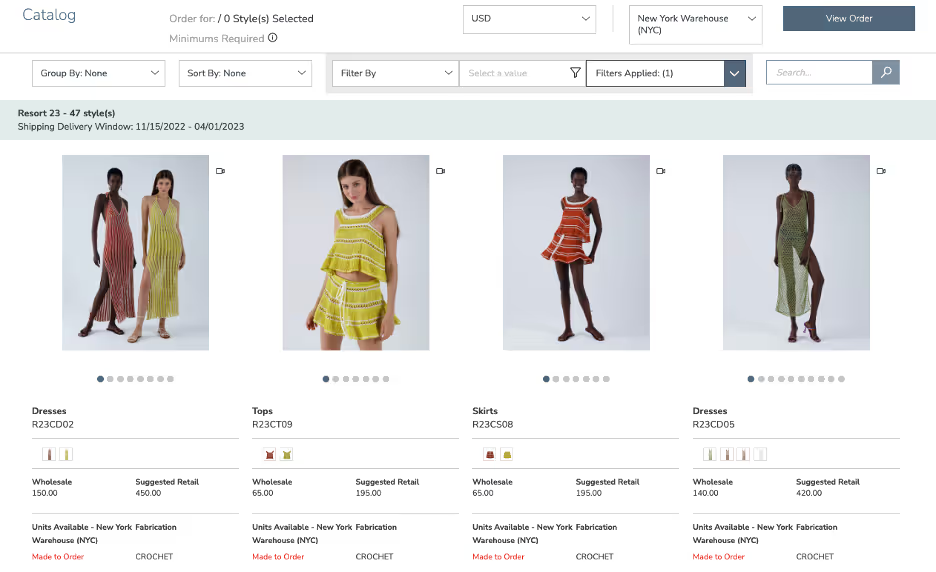
A line sheet features product information for every SKU.
What is a Lookbook?
A lookbook is an editorial-style catalog. This fashion industry tool adds extra context for specific collections or curated themes. For example, you can have a lookbook featuring Fall/Winter designs or perennial bestsellers. Create another lookbook focused on new-season colors or après-ski.
Brands use lookbooks to share the essence, mood, and inspiration behind specific collections or themes. Lookbooks focus on specific curations and beautiful layouts. However, they should always be representative of your brand’s overarching image and aesthetic. The best lookbooks enhance product images with vision and creativity.
Collections come to life via:
- Professional models
- Hair and makeup
- Accessories
- Styling
- Lighting
- Color palettes
- Locations, settings, atmosphere
These magazine-like books bring collections to life, while offering inspiration for marketing, visual merchandising, and styling. Buyers can also use them to gain a deeper understanding of garment construction and fit.
Benefits of Lookbooks in B2B Wholesale
Lookbooks captivate buyer interest while demonstrating perfect alignment with shoppers’ tastes. Brands can impress buyers with every season, capsule, or curated theme — all while encouraging sales. The best lookbooks are on-brand, visually-stunning productions. Professional photographers and models take things further, demonstrating construction, movement, and fit.
How lookbooks help:
- Clarify garment structure, fit, and feel (textures)
- Present a collection or theme in relevant lifestyle settings
- Offer editorial-like styling and merchandising inspiration
- Style core collection SKUs with new season designs
Example of a Lookbook
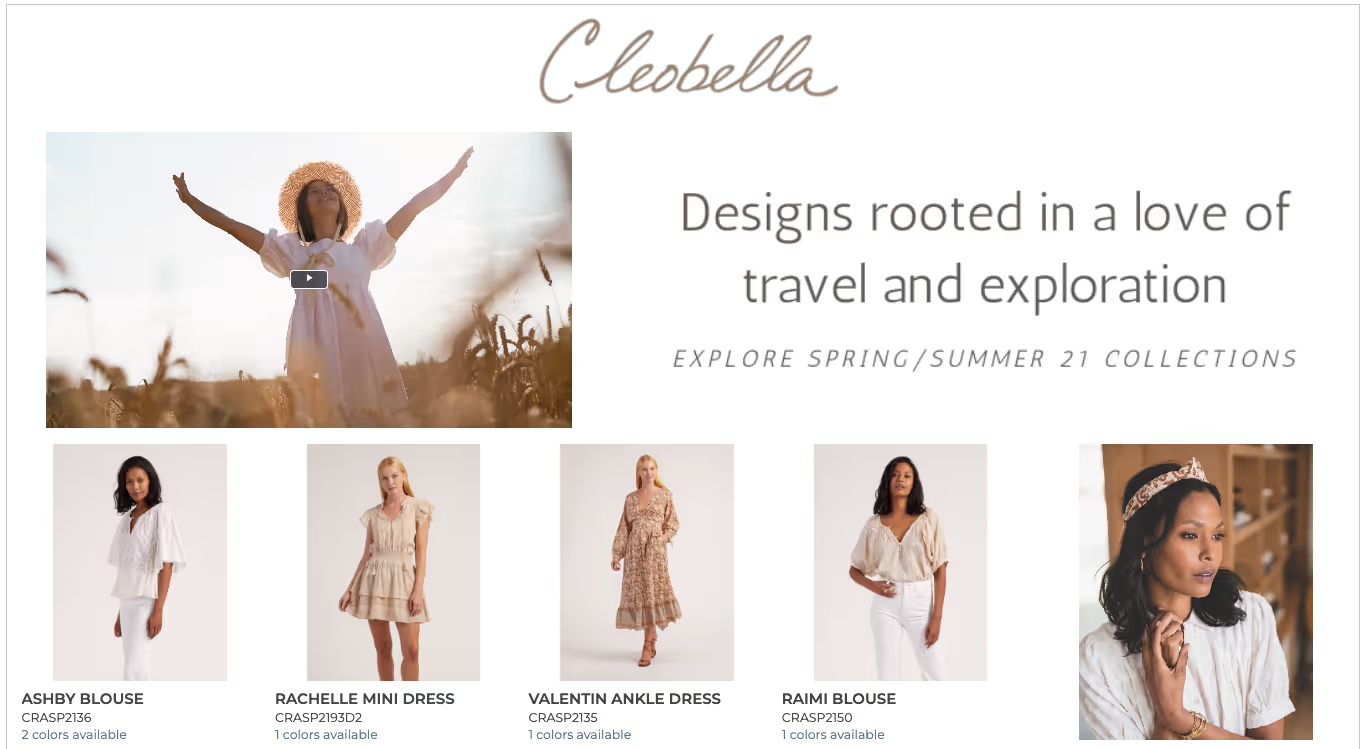
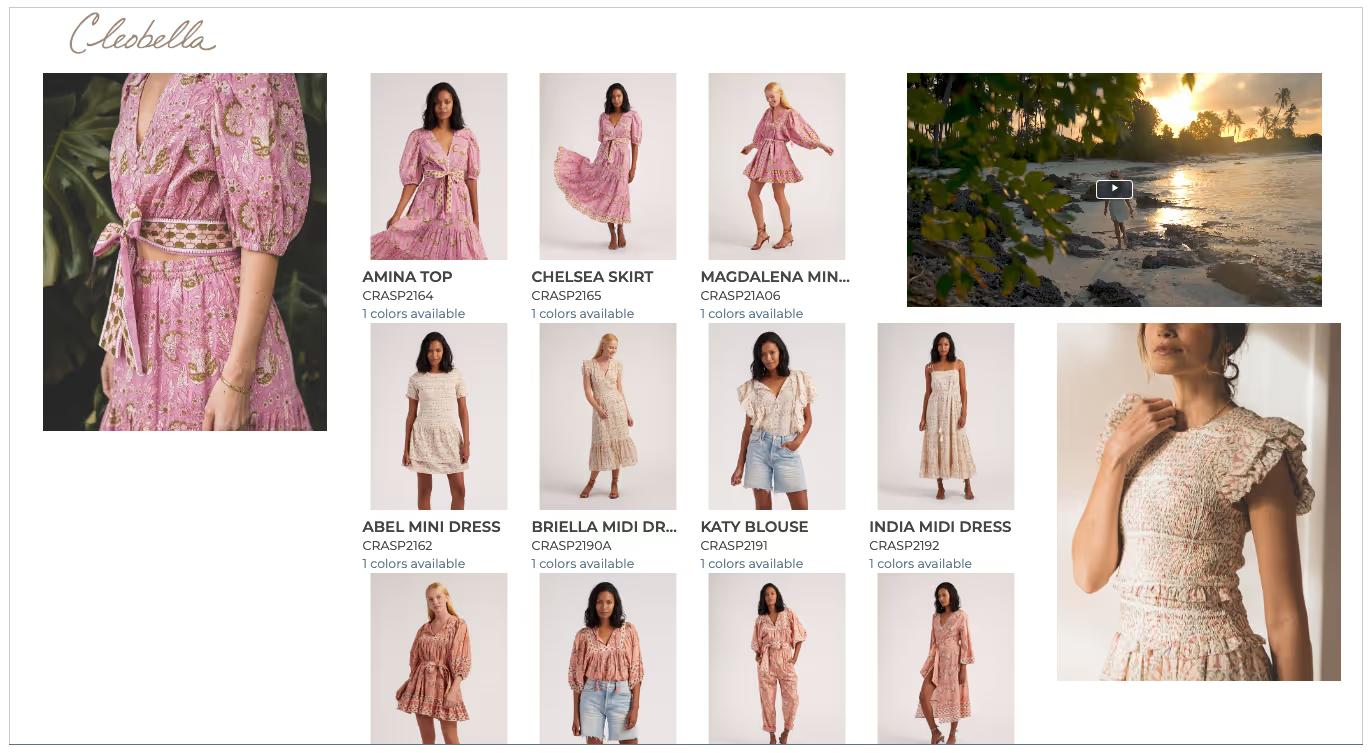
A lookbook brings a specific trend, theme, or collection to life. Notice the emphasis on beautiful, lifestyle-focused editorial images.
The Differences Between a Lookbook and a Line Sheet
It’s not uncommon to hear references to lookbooks and line sheets as if they’re one and the same. The main difference between a lookbook and a line sheet comes down to shopability.
That can get confusing. The truth is they’re two very different tools. Both B2B sales tools are timeless staples at virtual showroom appointments and live trade show events. However, buyers flip through lookbooks to get a better sense of a collection’s energy and inspiration.
Lookbooks can also share how specific garments might move. Meanwhile, buyers look to line sheets to access vital ordering information — sizing, colors, fabrics, and more. Unlike line sheets, lookbooks are marketing tools too. Brands can share them with buyers and the media, or use them to inspire shoppers on their sites.
Both lookbooks and line sheets might feature static images, videos, or a combination of the two.
Lookbook:
A lookbook is designed to convey the essence of a brand, containing imagery and descriptions of not only your products but your ethos.
Linesheet:
A line sheet provides the collection details necessary to inform buyers about your collection and allow them to shop effectively.
How to Create an Effective Line Sheet
The best line sheets leave little room for questions. That’s especially important when you’re selling 24/7 through a virtual showroom. Your line sheets might also be buyers’ first impression of your brand. Make it count.
Tip 1: Product Imagery
Include product images that represent key elements and features of every SKU. If a SKU has special features, like unusual proportions, share multiple images to display key angles.
Tip 2: Specific Information for Every SKU
Upload key product information for every SKU — and be sure to include details that would be impossible to detect at a glance. Remember to share product names too.
Tip 3: Utilize Tags for Different Categories
Finally, consider enhancing the buying process with valuable tags. You can identify top-selling items, core staples, exclusives, collaborations, and more. Buyers should be able to order directly from your digital line sheets. Let them zoom into images for more details, and see real-time inventory and pricing.
Effective Linesheets in Short
Aim to create a streamlined, shoppable document with accurate images and information.
- Upload product images of every SKU in your featured collection or assortment
- Curate items by categories or sub-themes (e.g. dress shirts, eveningwear, etc.)
- Upload key product information for every featured style
- Include contact information, ordering information, pricing and minimum quantities
How to Create an Effective Lookbook
It takes a team to produce a great lookbook. While your creative director might come up with the concept on their own, they’ll need on-set support too. There might be a photographer, photography assistants, hair and makeup artists, and a stylist. Depending on the needs of the shoot, there might be other assistants for tasks like steaming and managing garments.
Ideally, you’ll create a new lookbook for every season. Aim to inspire through styling choices, hair and makeup, and locations. Then tell a captivating story with rich visuals and plenty of emotion. Keep a copy of your style guide and visual standards on set to ensure every image is cohesive and on-brand. And ensure that your designs take center stage.
Feel free to add an inspirational blurb about the collection, but if you do, keep it short. The result should be an artistic, highly-polished, visually-focused document.
Effective Lookbooks in Short
- Develop a concept/theme that aligns with the inspiration or aesthetics of the featured collection
- Book and manage a professional photoshoot
- At the shoot: ensure your products look amazing, and that everything is consistent with the world of your brand
- After the shoot: create a digital lookbook and a few print copies to share at showroom appointments and other in-person events
Where Line Sheets and Lookbooks Are Used
Most industries, from fashion and beauty to homeware and lifestyle, use lookbooks to showcase their products to potential buyers. High-quality imagery that features in the products in situ can be a powerful tool to help retailers envisage how they might display an item in store, and also how it might fit into their customers' lifestyles.
Linesheets are similarly used across a wide range of industries, as they are an easy way to catalog products so buyers can quickly find all the key information they need. From sizes to color variants and MOQs, a linesheet should leave a buyer with no further questions other than, “Can you place my order?”
ERP Integration and Digital Enhancements
Digital tools like 360 degree imagery and video capabilities can be used to make your lookbooks more appealing to buyers for a truly immersive virtual shopping experience.
Similarly, ERP systems with digital enhancements will allow you to update your shoppable linesheets in real time, so you can edit the pricing, inventory and product data with the most recent information for buyers.
Why Fashion Brands Need Both Tools
A lookbook is crucial for showcasing a product’s potential, but it does not contain enough information alone to help you make a sale. A strong linesheet needs to be presented alongside your lookbook to reinforce your beautiful visuals with the clear and accurate information buyers need to complete the sales process.
Think of your lookbook as your inspiration tool, and your linesheet as your conversion tool, both working together to support a buyer as they complete the B2B journey with your brand.
Future Trends in Line Sheets and Lookbooks
AI will be instrumental to linesheet and lookbook creation in the coming years as software that generates automated pricing, product grouping, or assortments becomes available.
Predictive analytics will help brands decide which products to display in each of the formats, while augmented reality will take the formats themselves to a whole new level of buyer-brand immersion.
Line Sheets vs Lookbooks: How JOOR Can Help

It’s a great idea to upload your lookbooks to your B2B digital wholesale platform. Buyers will be able to access everything they need in one place. But did you know you can create interactive line sheets with JOOR?
JOOR enhances line sheets with the power of e-commerce. Quickly create and share shoppable line sheets to help buyers order with confidence. Upload line sheets or edit easy-to-use, drag-and-drop templates. Create your own size charts, and highlight certifications and fabric composition. Use badges to note sustainable designs, limited editions, and exclusives. Then take advantage of features like filters, 360° images and videos, and collaborative editing.
Encourage deeper collaboration between retailers and brands. Use in-platform messaging and create custom line sheets with exclusive assortments. Then integrate your inventory management software for real-time, accurate inventory information. Smart analytics offer insights into what buyers love most, sell-through rates, and more.
FAQs
Do buyers want to look at lookbooks or linesheets first?
Whether a buyer wishes to see a lookbook or linesheet first will depend on their personal preference. If they already have an understanding of your brand and are just interested in seeing the new pieces in a collection a linesheet may be preferable. If they are just coming into contact with your brand for the first time, they may wish to see a lookbook first to get context about what you offer.
Should small fashion brands use both lookbooks and line sheets, or are they only for big companies?
Fashion brands of all sizes can use lookbooks and linesheets to help sell their collections and showcase them in a way that’s easier for buyers to understand.
What are the mistakes brands should avoid when creating a lookbook?
Avoid overcomplicated designs and poor quality images when creating your lookbook as these can turn buyers off. Try not to have a lack of contact information either, as buyers also find this frustrating.
Can line sheets integrate directly with ERP or inventory systems?
Yes, many ERP systems including JOOR can directly integrate with linesheets.
Which tool is better for boosting seasonal sales: a lookbook or a line sheet?
Lookbooks and linesheets are both equally valuable when trying to boost seasonal sales. A lookbook will display your collection in an eye-catching way with lifestyle imagery to help showcase your creative vision and how the product could be worn, whereas a linesheet will contain all the key information buyers need to make a wholesale purchase.
Related Insights
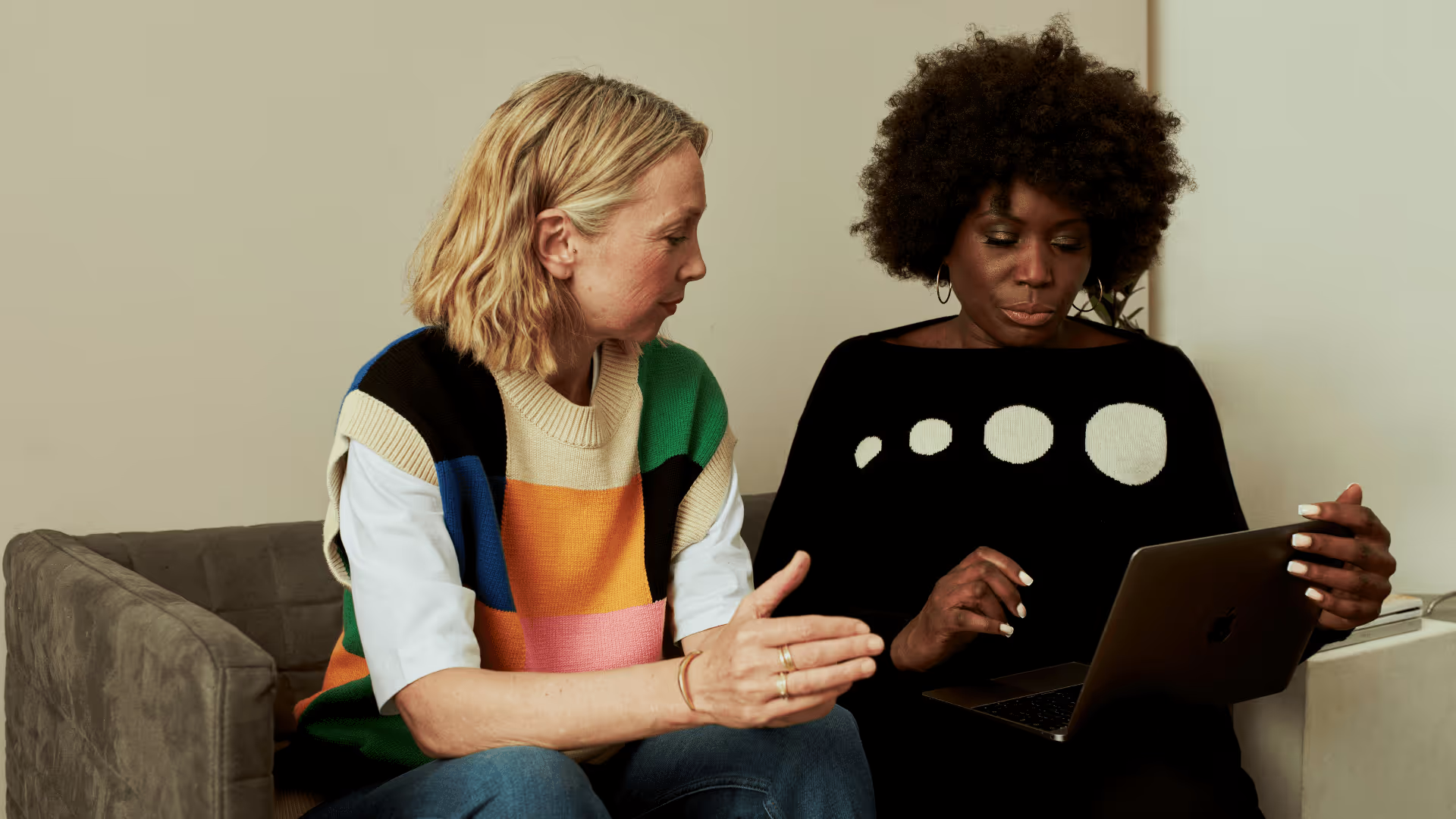
Why Digital B2B Catalogs are Essential for E-Commerce Businesses
Online catalogs have become a crucial component for retailers and their buyers in an evermore tech reliant industry. Read about how these dynamic product libraries act as comprehensive selling solutions that plug into current buying behaviors.
%2520(2)%2520(1).avif)
8 Ways a B2B Fashion Marketplace Solves Wholesale Scaling Challenges
Learn how a B2B fashion marketplace like JOOR helps your wholesale fashion brand overcome scaling challenges. Maximize resources, build retailer relationships, and enhance distribution to drive growth in the global wholesale fashion market.
%2520(1).avif)
Price Sheets Vs Line Sheets in Wholesale Fashion
Explore the key differences between price sheets and line sheets in wholesale fashion. Optimize product showcasing and sales strategies with clear pricing details and captivating visuals. Enhance buyer experience and streamline ordering process effectively.
.avif)


